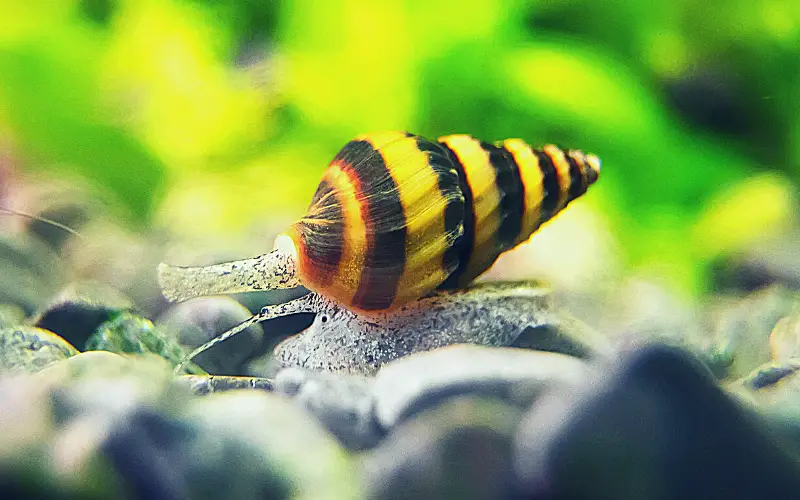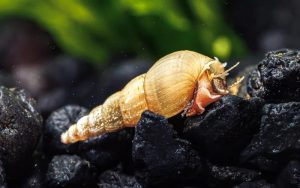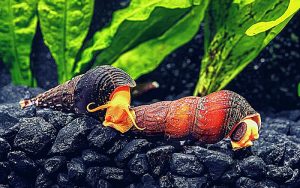How often do assassin snails eat? Assassin snails, with their yellow and dark brown shell, are popular aquarium snails valued for their ability to help control pest snail populations in fish tanks.
These carnivorous snails are named for their predatory behavior, as they feed primarily on other snails, especially those considered pests in aquariums.
One common question among aquarium enthusiasts is how often assassin snails need to eat to maintain their population in a tank.

Unlike other types of snails, assassin snails do not need to be fed regularly with commercial fish food. Their diet primarily consists of other snails, so as long as enough pest snails are present in the tank, the assassin snails will have a steady supply of food.
In this article, we will delve into the feeding habits of assassin snails and provide tips on keeping them well-fed and healthy in your aquarium.
Table of Contents
ToggleHow Often Do Assassin Snails Eat?
Assassin snails don’t need a set feeding schedule like fish do. They are opportunistic feeders, which means they eat when prey is available. In the aquarium, this translates to:
- If there are plenty of pest snails, They might eat every day or every other day.
- If pest snails are scarce, They can go between meals for several days or weeks.
Here are some additional factors that can influence how often assassin snails eat:
- Number of assassin snails: More snails means more competition for food, so they may need to eat more frequently.
- Size of the tank: In a smaller tank, less food will be available, so they may need to eat more often.
Even if there aren’t many pest snails, assassin snails can survive by scavenging for leftover fish food or eating detritus (organic waste) in the aquarium. But for long-term health, it’s a good idea to supplement their diet with occasional treats like bloodworms, brine shrimp, or even chopped shrimp.
Will Assassin Snails Starve?
Assassin snails are carnivorous freshwater snails that are often kept in planted tanks to control populations of smaller snails, such as Malaysian trumpet snails and ramshorn snails. These snails prefer to eat other snails and will even consume snail eggs.

When it comes to their food source, assassin snails will also eat fish flakes, blood worms, and dead organisms in the tank.
However, if there are not enough snails, assassin snails may become hungry and feed on snail shells. It is essential to provide a proper diet for assassin snails to ensure they do not starve.
Assassin snail care includes maintaining good water quality and appropriate water conditions for aquatic creatures. It is also recommended to perform regular water changes and provide a soft substrate in the tank.
When adding new assassin snails to a tank, it is best to introduce them gradually and monitor their behavior toward other tank mates. Assassin snails are not aggressive towards most snail species and can coexist peacefully in a community tank.
How Much Food Do Assassin Snails Need?
Assassin snails cannot survive solely on algae or leftover fish food, so a consistent diet is essential. Keeping a small group of assassin snails in the tank is recommended to ensure proper breeding of assassin snails.
When buying assassin snails, consider your aquarium’s tank size and water parameters to ensure they have enough space and suitable conditions to thrive.
Assassin snails prefer eating trumpet snails, so having a population of these snails in the tank can help keep the assassin snails well-fed. They are also known for eating snail eggs and can be a helpful addition to a tank with rabbit or mystery snails.
Housing and Tank Conditions
Assassin snails (Clea Helena) are a popular choice for freshwater aquariums, especially those with a problem with pest snails like trumpet snails or ramshorn snails. They’re voracious predators and can help to keep the population of unwanted snails in check.
But before you introduce assassin snails to your tank, you must ensure you can provide them with the proper housing and tank conditions.
Tank Size
Assassin snails don’t require a lot of space, but a minimum of 2 gallons per snail is recommended. This will help ensure enough resources are available for them to thrive. A tank that is too small can lead to fluctuations in water parameters, which can be stressful for assassin snails.
Water Parameters
Assassin snails are relatively adaptable when it comes to water parameters, but they prefer the following:
- Temperature: 68°F – 75°F (20°C – 24°C)
- pH: 6.5 – 8.0
- KH: 2 – 15 dKH
It’s important to note that assassin snails are sensitive to copper. Be sure to avoid any medications or plant fertilizers containing copper, as this can be fatal.
Tank Setup
Assassin snails are freshwater snails, and they are not picky about decor but appreciate hiding places. Live plants are a great option, as they not only provide hiding spots but also help to improve water quality. The substrate should be fine, as assassin snails burrow for food.
Diet
Assassin snails are carnivores and eat other pond snails, residue, and leftover fish food. If there aren’t enough pest snails in your tank to sustain them, you can supplement their diet with sinking carnivore pellets or frozen bloodworms.
Tankmates
Assassin snails can be peaceful community tank dwellers, but they should not be kept with tiny fish or shrimp, as they may prey on them. They also eat neon tetras and other small, slow, or sick fish. Good tankmates for assassin snails include:
- Gouramis
- Danios
- Barbs
- Rasboras
- Corydoras catfish
Assassin snails can be a valuable addition to your freshwater aquarium with proper care. They will help to keep the population of pest snails in check and are relatively easy to care for.
Commonly Asked Questions about How Often Do Assassin Snails Eat (FAQs)
What will assassin snails eat if there are no snails?
A hungry assassin snail won’t be too picky! They’ll scavenge for algae, leftover fish food, or even bloodworms to survive.
Do you need to feed assassin snails?
You don’t necessarily need to feed assassin snails if you are keeping them for pest control. They’ll eat algae, fish flakes or hunt other snails. But for long-term care, occasional bloodworms are a good idea.
Will Assassin Snails overpopulate a tank?
Assassin snails usually self-regulate. Their reproduction slows when prey (other snails) are scarce. Baby assassin snails need other snails to survive.
What to do with too many assassin snails?
With no more pest snails, consider if you want to keep assassin snails. They’ll adapt to eating algae, fish flakes, or even bloodworms.
Will assassin snails eat pellets?
Yes, Larger snails will eat pellets! They’re opportunistic feeders and enjoy leftover fish pellets as a food source.
What is an alternative food for assassin snails?
In their natural habitat, if prey is scarce, assassin snails will scavenge for detritus (decaying organic matter) or consume bloodworms.
How do assassin snails give birth?
Assassin snails don’t give birth! They are hermaphrodites, meaning both males and females. They lay single eggs that hatch into miniature assassin snails.
Conclusion
In conclusion, understanding the feeding habits of assassin snails is crucial for their care and maintenance in aquariums. These stealthy creatures, known for their ability to control pest snail populations, have an intriguing appetite. While assassin snails primarily feed on other snails, they are not voracious eaters. They take their time and eat at their own pace, ensuring a balanced ecosystem in your tank. It’s important to note that the frequency of their meals depends on several factors, including the availability of prey and the size of the snail population.
By providing a suitable environment and monitoring their feeding patterns, you can ensure the well-being of these fascinating little assassins. So, if you’re wondering, “How often do assassin snails eat?” remember that it varies, but they will instinctively seek out their prey when hungry.
You might also Like
- Assassin Snail Vs Malaysian Trumpet Snail: Tankmates or Foes
- Do Assassin Snails Eat Snail Eggs: (Shocking Truth Revealed)
- What Eats Assassin Snails: 5 Surprising Predators Revealed!
- Do Assassin Snails Eat Each Other: Myths & Facts! (Revealed)
- Will Assassin Snails Eat Nerite Snails: (The Shocking Truth)
- Assassin Snail Eating 101: A Comprehensive Beginners Guide





